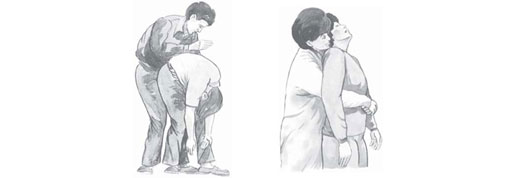First Aid
4. Respiratory Arrest
Respiratory arrest or asphyxia is produced when breathing stops, the brain stops receiving oxygen and the person loses consciousness. We are then faced with an unconscious person (who is immobile and does not respond to stimuli), who does not breathe, although he still has a pulse.
We can find this situation in a person who has suffered an accident, since, after 5 minutes of respiratory arrest, the heart fails due to the lack of oxygen and we find ourselves faced with cardiorespiratory arrest.
4.1. Causes of Respiratory Arrest
Breathing may stop due to:
- 1) Foreign bodies obstructing the airway. The airway is only prepared for the passage of air. Choking is produced when a body, whether solid or liquid, enters the airway, and may result in respiratory arrest.
- 2) Inhaling fumes or toxic gases. When breathing in an atmosphere with a low oxygen content, the respiratory centre in the brain is inhibited, thus producing respiratory arrest.
- 3) Strangulation or strong blows to the trachea, which may lead to rupture or crushing. This often occurs in traffic accidents.
- 4) Electrocution. When an electrical discharge occurs, the person is “stuck” to the source of electricity, possibly causing paralysis of the respiratory muscles and respiratory arrest.
- 5) Choking. Obstruction of the airway is likewise produced in these cases and hence respiratory arrest.
- 6) Overdose of drugs such as barbiturates. These cause depression of the central nervous system and respiratory depression.
4.2. Choking
The airway and the digestive tract have shared cavities such as the mouth and pharynx. Sometimes when eating, just at the moment in which the food bolus is about to be swallowed, the person aspires and part of the food enters the airway, blocking respiration and closing off the passage of air.
Rapid action has to be taken in these cases, otherwise respiratory arrest occurs.
When the obstruction of the airway is complete, the person stands up, usually with the aim of asking for help and places his hand on his neck, cannot speak, cannot cough and cannot breathe, his face goes red and his eyes stand out, as if he were being strangled .
In these cases, stand behind the person, lean him forwards and give him three sharp blows between the shoulder blades.
If he does not expel the object, press the abdomen four times. This is what is known as the Heimlich manoeuvre: by brusquely pressing on the abdomen, the diaphragm rises suddenly pushing the pulmonary bases, the lungs empty and expel the air that could drag the object with it as it exits.
After a few minutes, if you have not managed to extract the object, the person loses consciousness and falls to the floor. In this case, call for emergency aid and while waiting begin artificial respiration, since air sometimes enters the lungs when you insufflate, even though the object has not been removed.





